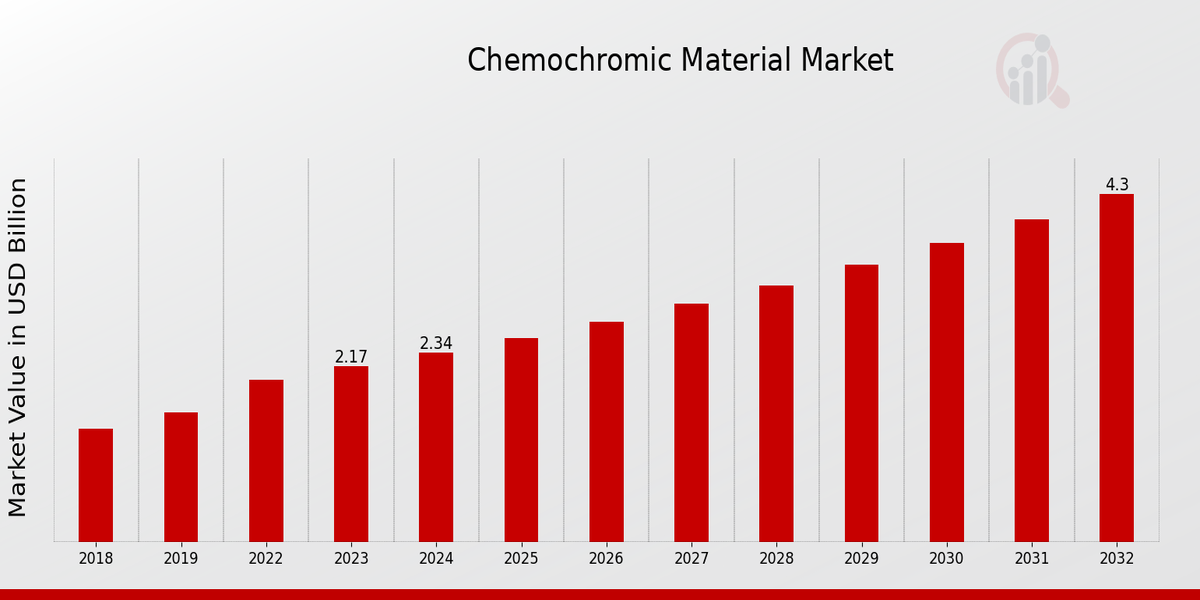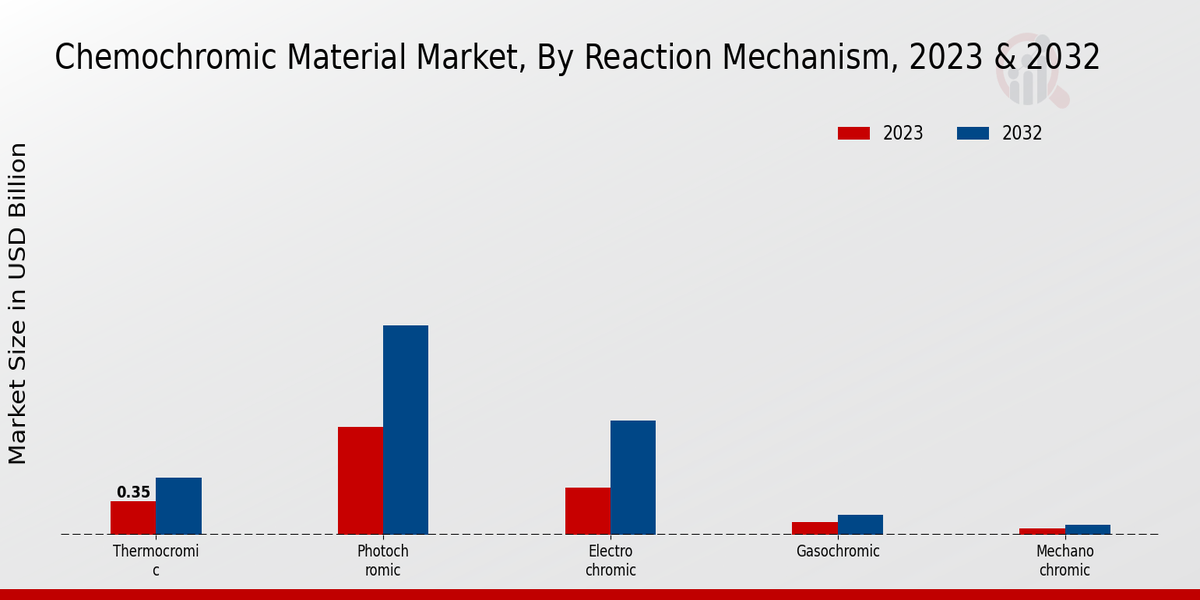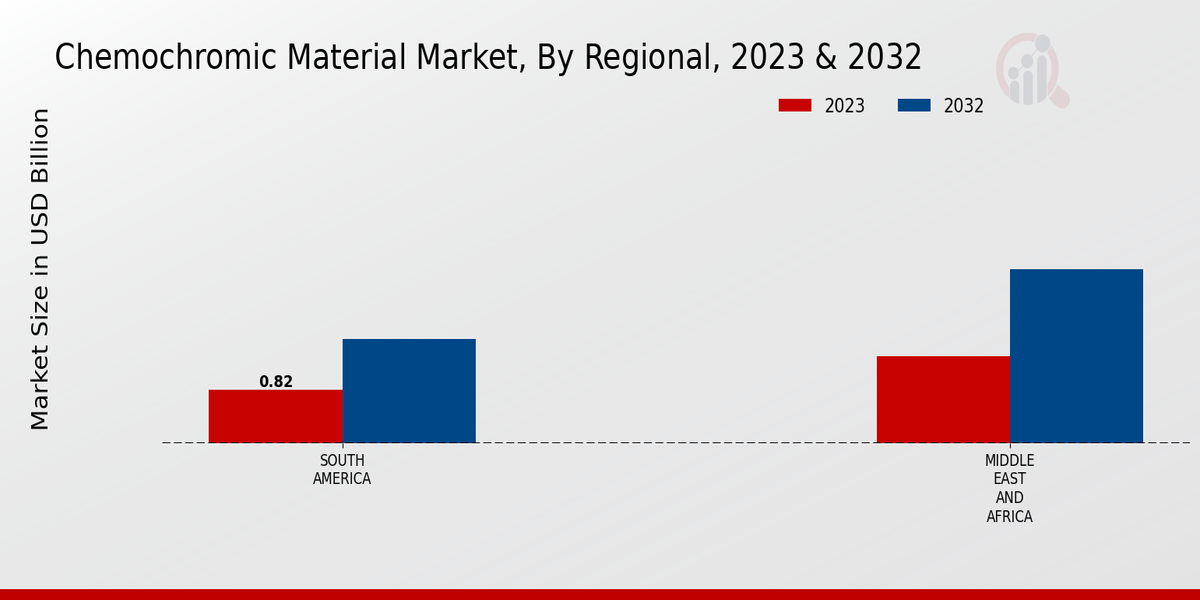Global Chemochromic Material Market Overview
The Chemochromic Material Market Size was estimated at 2.53 (USD Billion) in 2024. The Chemochromic Material Industry is expected to grow from 2.73 (USD Billion) in 2025 to 5.41 (USD Billion) by 2034. The Chemochromic Material Market CAGR (growth rate) is expected to be around 7.9% during the forecast period (2025 - 2034).
Key Chemochromic Material Market Trends Highlighted
The primary market drivers for chemochromic materials are their properties of color or tint change when exposed to particular stimuli such as thermal, optical, or chemical stimuli. This property gives them a wide range of applicability in many areas, like optical sensors, displays, textiles, and security features. To be addressed in the chemochromic material market are the opportunities to create further SOS materials with more sensitivity, quicker response speeds, and greater toughness.
One of the recent developments in the market is the application of chemochromic materials with other types of materials, such as nanomaterials and electronics with bending capabilities. This synergetic effect is bringing the emergence of smart applications like packaging material that can change color to indicate the spoilage of contents or smart coatings that change color to repair any damage sustained. Capitalizing on these trends will allow manufacturers to design new products that will stand alone or easily be brought into existing products against the ongoing needs of end-user industries.

Source: Primary Research, Secondary Research, MRFR Database and Analyst Review
Chemochromic Material Market Drivers
Increasing Demand for Smart and Responsive Materials
The Chemochromic Material Market is primarily driven by the rising demand for smart and responsive materials in various industries. Chemochromic materials are gaining popularity due to their unique ability to change color in response to specific chemical stimuli, making them ideal for applications in sensing, display technologies, and security features. The growing adoption of these materials in industries such as consumer electronics, automotive, and healthcare is fueling market growth.Furthermore, the increasing demand for advanced materials for optical sensing and data storage applications is contributing to the market's expansion. The Chemochromic Material Market Industry is expected to witness significant growth in the coming years, driven by the increasing demand for smart materials and the growing adoption of these materials in various industries.
Advancements in Nanotechnology and Material Science
Technological progress in the field of nanotechnology and material science has enabled the development of novel chemochromic materials and the enhancement of their properties. Thus, scientists are focused on the elaboration of new synthesis methods and material combinations that would allow for improving the sensitivity of the materials, their transparency, and response time, and reduce the heterogeneity of the response, and increase stability. The chemochromic materials are stated to be suitable for application in advanced sensing systems, optical devices, and biomedical research, and their properties can be tailored with the help of nanotechnology applications.In such a way, the shift in the industry will continue to be driven by the current research and development.
Government Initiatives and Environmental Regulations
In addition to the rising public concerns toward sustainability and environmental impact over the past few years, government initiatives, as well as environmental regulations, are propelling the demand for chemochromic materials and associated devices. These materials provide sustainable alternatives for existing sensing and related technologies, as they are non-toxic, reusable, and can be incorporated into sustainable manufacturing processes. The increasing awareness regarding the environmental benefits of chemochromic materials drives their adoption across a variety of industries, contributing to the overall growth of the market.Moreover, environmental regulations that restrict the use of hazardous materials for the production of consumer goods and across industrial processes further the application of chemochromic materials due to their safety and sustainability.
Chemochromic Material Market Segment Insights
Chemochromic Material Market Reaction Mechanism Insights
The Chemochromic Material Market is segmented on the basis of reaction mechanism as thermochromic, photochromic, electrochromic, gasochromic, and mechanochromic. The photochromic segment is expected to dominate the market during the forecast period and is projected to reach USD 1.6 billion by 2024, at a CAGR of 8.2% during the forecast period. This market dominance is attributed to the rising demand for photochromic materials in applications such as sunglasses, automotive mirrors, and architectural glazing. Further, the electrochromic segment is projected to be the fastest-growing segment in this market, which is anticipated to reach USD 0.7 billion by 2024 at a CAGR of 9.1% during the forecast period.This growth is attributed to the increasing popularity of electrochromic materials in smart windows and displays. The thermochromic segment is expected to dominate the market and is projected to reach USD 0.5 billion by 2024, at a CAGR of 7.8%. This market dominance is due to the rising demand for thermochromic materials in temperature-sensitive applications such as medical devices and packaging. The gasochromic segment is anticipated to be the small segment in this market, which is projected to reach USD 0.2 billion by 2024, at a CAGR of 6.5%.This market size is due to the increasing market demand for gasochromic materials in gas sensing applications. The mechanochromic segment is also projected to be the small segment in this market and is anticipated to reach USD 0.1 billion by 2024 at a CAGR of 5.9%. This market situation is because of the increasing market demand for mechanochromic materials to distinguish security applications such as anti-counterfeiting and tamper-evident packaging.

Source: Primary Research, Secondary Research, MRFR Database and Analyst Review
Chemochromic Material Market Application Insights
The Chemochromic Material Market segmentation by Application includes Displays, Smart Windows, Sensors, Security, and Biomedical. The Displays segment held the largest market share in 2023 and is expected to continue its dominance throughout the forecast period. The growth of this segment can be attributed to the increasing demand for chemochromic materials in various display applications, such as electronic paper, smartwatches, and automotive displays. The Smart Windows segment is also expected to witness significant growth due to the rising adoption of smart buildings and the increasing demand for energy-efficient solutions.The Sensors segment is anticipated to grow at a steady pace due to the increasing use of chemochromic materials in chemical and biological sensing applications. The Security segment is expected to witness moderate growth due to the growing demand for security features in various applications. The Biomedical segment is expected to grow at a robust pace due to the increasing use of chemochromic materials in medical imaging and diagnostics. The Chemochromic Material Market revenue for the Displays segment is projected to reach USD 1.2 billion by 2024, while the Smart Windows segment is expected to reach USD 0.5 billion by the same year.
Chemochromic Material Market Substrate Insights
The Chemochromic Material Market is segmented into various substrates, including organic, inorganic, metal-organic frameworks, and polymers. Among these, organic substrates hold a significant market share due to their versatility and ease of modification. Organic substrates are typically composed of carbon-based materials, such as dyes and pigments, which exhibit reversible color changes in response to specific stimuli. The Chemochromic Material Market for organic substrates is projected to grow at a CAGR of 8.2% from 2024 to 2030, reaching a market value of USD 1.2 billion by 2030.Inorganic substrates, on the other hand, are composed of metal oxides and other inorganic compounds. They offer high durability and stability but may have limited color-changing capabilities. Metal-organic frameworks (MOFs) are hybrid materials that combine organic and inorganic components. They exhibit unique properties, including high porosity and surface area, which make them promising for various applications in the chemochromic material market. Polymers are another important substrate type, offering flexibility, low cost, and the ability to be tailored for specific applications.The market for chemochromic materials based on polymers is expected to witness significant growth due to their use in sensors, displays, and other applications.
Chemochromic Material Market Form Insights
Powders accounted for the largest share of the Chemochromic Material Market in 2023 and are projected to maintain their dominance throughout the forecast period. The high demand for powders can be attributed to their versatility and ease of application. Powders can be easily dispersed in various solvents and polymers, making them suitable for a wide range of applications, including inks, paints, and coatings. Films are another important segment of the chemochromic material market. Films are typically made of thin layers of chemochromic materials and are used in applications where color change is desired over a large surface area.Films are commonly used in smart windows, displays, and packaging. Coatings are also a significant segment of the chemochromic material market. Coatings are typically applied to surfaces to impart color-changing properties. Coatings are used in a variety of applications, including automotive, aerospace, and consumer electronics. Liquids are the smallest segment of the chemochromic material market. Liquids are typically used in applications where color change is desired in a liquid medium. Liquids are used in a variety of applications, including cosmetics, medical diagnostics, and security features.
Chemochromic Material Market Color Change Insights
The Color Change segment of the Chemochromic Material Market is segmented into Reversible, Irreversible, and Multi-Color. The Reversible segment accounted for the largest market share in 2023, and is projected to continue to grow at a CAGR of 7.9% from 2024 to 2032. The Irreversible segment is expected to grow at a CAGR of 7.5% during the forecast period. The Multi-Color segment is expected to grow at a CAGR of 8.1% during the forecast period. Reversible chemochromic materials are those that can change color multiple times when exposed to different stimuli.Irreversible chemochromic materials are those that can only change color once when exposed to a specific stimulus. Multi-Color chemochromic materials are those that can change to multiple colors when exposed to different stimuli. The growth of the Color Change segment is being driven by the increasing demand for chemochromic materials in various applications, such as sensors, displays, and textiles. Chemochromic materials are used in sensors to detect the presence of specific chemicals. They are also used in displays to create dynamic and interactive images.In textiles, chemochromic materials are used to create color-changing fabrics that can be used in clothing, accessories, and home décor.
Chemochromic Material Market Regional Insights
The Chemochromic Material Market is expected to reach a value of USD 2.6 billion by 2024, exhibiting a CAGR of 8.5% during the forecast period. Regionally, North America is expected to hold the largest market share, followed by Europe and APAC. The growth in North America can be attributed to the increasing adoption of chemochromic materials in various industries, such as automotive, aerospace, and healthcare. Europe is expected to witness a significant growth rate due to the rising demand for smart and functional materials in the region.APAC is projected to be the fastest-growing region, driven by the increasing demand for chemochromic materials in the packaging and consumer electronics industries. South America and MEA are expected to experience moderate growth, owing to the growing awareness about the benefits of chemochromic materials and the increasing investment in infrastructure development.

Source: Primary Research, Secondary Research, MRFR Database and Analyst Review
Chemochromic Material Market Key Players And Competitive Insights
Major players in the Chemochromic Material Market industry have adopted various organic and inorganic growth strategies such as partnerships, acquisitions, and research and development to become key Chemochromic Material Market market players. Leading players focus on providing a complete range of products for end-users to cater to their diverse requirements. Furthermore, by investing in constant research and development, Chemochromic Material Market market players focus on providing innovative products and increasing their market reach. Mergers and acquisitions have been a key strategy in the Chemochromic Material Market industry, and leading players have acquired companies to enter the Chemochromic Material Market market and achieve a competitive edge. Moreover, acquisitions have helped companies gain access to new technologies and the required expertise to excel in Chemochromic Material Market development.
For instance, Sun Chemical is a top provider of a variety of chemochromic pigments, inks and solutions. With its global presence and reach, the company provides customized solutions across applications in various industries. The company’s investment in research and development has helped it emerge as a key player in Chemochromic Material Market.
Similarly, DIC Corporation is one of the leading competitors in the Chemochromic Material Market, known for its innovative solutions for colors and materials. It offers a variety of materials such as thermochromic, photochromic, and electrochromic and others, which cater to the applications in varied industries. DIC Corporation’s focus on partnerships and collaborations has helped it to reach out to wider range of customers and introduce new products in the market. The company has been focusing on reducing its environmental impact and has been developing eco-friendly solutions.
Key Companies in the Chemochromic Material Market Include
- Kusumoto Chemicals., Ltd.
- IGM Resins Ltd.
- Merck
- Fuji Pigment Co., Ltd.
- Belle Chemical Co. Ltd.
- TPC Materials Inc.
- Kataura Chemicals Co. Ltd.
- 3A Composites GmbH
- Gentec Optics Inc.
- Chroma Color Corporation
- Sensient Technologies Corporation
- Polysciences, Inc.
- IGP Group
- Vito Chemicals N.V.
- Chromatic Technologies Inc.
Chemochromic Material Market Industry Developments
The Chemochromic Material Market is projected to reach USD 5.41 billion by 2034, exhibiting a CAGR of 7.9% from 2025 to 2034. Rising demand for color-changing materials in various applications, including security features, anti-counterfeiting measures, and temperature indicators, is driving market growth. Furthermore, advancements in nanotechnology and the development of new chemochromic materials with enhanced properties are contributing to market expansion. The automotive industry is a major end-user, utilizing chemochromic materials for temperature monitoring and color-changing displays. Ongoing research and development efforts are expected to further fuel market growth in the coming years.
Chemochromic Material Market Segmentation Insights
- Chemochromic Material Market Reaction Mechanism Outlook
- Thermocromic
- Photochromic
- Electrochromic
- Gasochromic
- Mechanochromic
- Chemochromic Material Market Application Outlook
- Displays
- Smart Windows
- Sensors
- Security
- Biomedical
- Chemochromic Material Market Substrate Outlook
- Organic
- Inorganic
- Metal-Organic Frameworks
- Polymers
- Chemochromic Material Market Form Outlook
- Powders
- Films
- Coatings
- Liquids
- Chemochromic Material Market Color Change Outlook
- Reversible
- Irreversible
- Multi-Color
- Chemochromic Material Market Regional Outlook
- North America
- Europe
- South America
- Asia Pacific
- Middle East and Africa
| Report Attribute/Metric |
Details |
| Market Size 2024 |
2.53(USD Billion) |
| Market Size 2025 |
2.73(USD Billion) |
| Market Size 2034 |
5.41(USD Billion) |
| Compound Annual Growth Rate (CAGR) |
7.90% (2025 - 2034) |
| Report Coverage |
Revenue Forecast, Competitive Landscape, Growth Factors, and Trends |
| Base Year |
2024 |
| Market Forecast Period |
2025 - 2034 |
| Historical Data |
2020 - 2024 |
| Market Forecast Units |
USD Billion |
| Key Companies Profiled |
Kusumoto Chemicals., Ltd., IGM Resins Ltd., Merck, Fuji Pigment Co., Ltd., Belle Chemical Co. Ltd., TPC Materials Inc., Kataura Chemicals Co. Ltd., 3A Composites GmbH, Gentec Optics Inc., Chroma Color Corporation, Sensient Technologies Corporation, Polysciences, Inc., IGP Group, Vito Chemicals N.V., Chromatic Technologies Inc. |
| Segments Covered |
Reaction Mechanism, Application, Substrate, Form, Color Change, Regional |
| Key Market Opportunities |
Growing demand in medical diagnostics, Anti-counterfeiting applications, Smart packaging and printable electronics |
| Key Market Dynamics |
Increasing demand for counterfeit protection, rising usage in smart textiles, growing adoption in automotive interiors, advancements in color-changing technology, increasing government regulations |
| Countries Covered |
North America, Europe, APAC, South America, MEA |
Frequently Asked Questions (FAQ) :
The Chemochromic Material Market is anticipated to reach USD 2.53 billion in 2024.
The Chemochromic Material Market is projected to reach USD 2.53 billion by 2034, growing at a CAGR of 7.90% from 2025 to 2034.
Asia Pacific is expected to account for the largest market share due to the increasing demand for chemochromic materials in various industries such as automotive, electronics, and healthcare.
Key applications of chemochromic materials include color-changing displays, sensors, smart textiles, and security features.
Major players in the Chemochromic Material Market include Merck, Gentec, Inc., and Sun Chemical.
The growth of the Chemochromic Material Market is driven by increasing demand for advanced materials in various industries and the rising adoption of chemochromic materials in consumer electronics.
Challenges faced by the Chemochromic Material Market include high production costs and technical limitations in large-scale manufacturing.
Opportunities for growth in the Chemochromic Material Market lie in the development of new applications, such as in wearable devices and smart packaging.
Technological advancements are expected to drive innovation in chemochromic materials, leading to the development of new products with improved performance and functionality.
Regulatory changes may affect the production, distribution, and use of chemochromic materials, influencing market dynamics.

















